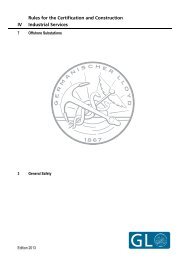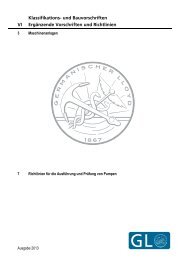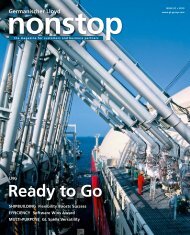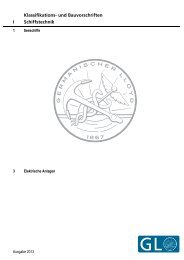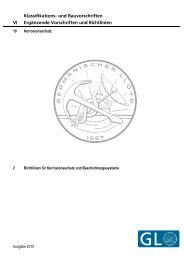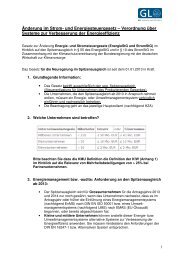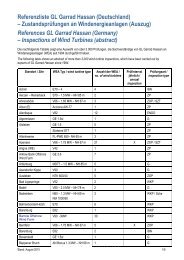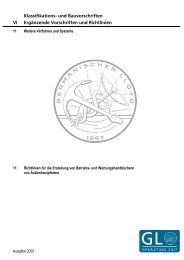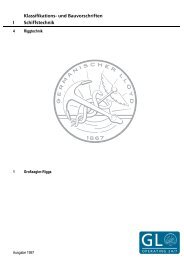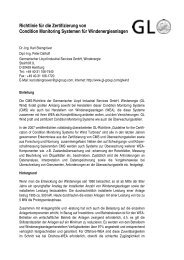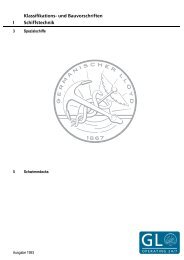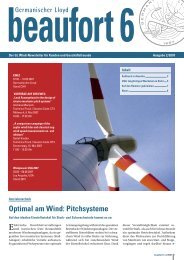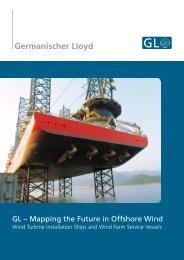In Focus LNG - GL Group
In Focus LNG - GL Group
In Focus LNG - GL Group
You also want an ePaper? Increase the reach of your titles
YUMPU automatically turns print PDFs into web optimized ePapers that Google loves.
02 I 2013<br />
<strong>LNG</strong><br />
Straight ahead to safe <strong>LNG</strong> bunker supply
<strong>LNG</strong> – driving change in shipping<br />
5%<br />
4%<br />
3%<br />
2%<br />
1%<br />
0%<br />
Sulphur content limits in bunker fuels<br />
Global<br />
2008<br />
2009<br />
2010<br />
2011<br />
2012<br />
2013<br />
2014<br />
2015<br />
2016<br />
2017<br />
2018<br />
Local<br />
2019<br />
2020
<strong>In</strong>troduction<br />
Future-proof solutions<br />
for greener shipping<br />
Stringent international regulations on emissions are forcing the shipping<br />
industry to rethink its fuelling options. The IMO has introduced<br />
emission controls, which will increasingly affect international shipping<br />
over the next decade. The introduction of ECAs in European, US and<br />
Canadian territorial waters means that shipowners must begin to consider<br />
alternatives to traditional heavy fuel oil.<br />
WWe at <strong>GL</strong> are supporting<br />
the industry at all levels to make<br />
ships more efficient and environmentally<br />
friendly. A key topic in<br />
this quest is liquefied natural gas<br />
(<strong>LNG</strong>) as an alternative to conventional<br />
fuels. Compared to oil, natural<br />
gas has an important advantage:<br />
It combines efficiency with a lower<br />
environmental impact.<br />
There are four aspects that, taken<br />
together, make <strong>LNG</strong> as ship fuel one<br />
of the most promising new technologies:<br />
1. Using <strong>LNG</strong> as ship fuel can reduce<br />
sulphur oxide (SO x ) emissions, which<br />
are created using fuel with a high<br />
sulphur content, by approximately<br />
90% to 95%. This reduction will<br />
become mandatory within the socalled<br />
Emission Control Areas from<br />
2015 on. A similar reduction will be<br />
enforced for worldwide shipping<br />
from 2020 on, pending a review at<br />
IMO which may move the introduction<br />
to 2025.<br />
2. Reduction of nitrogen oxide (NO x )<br />
emissions down to IMO Tier III limits,<br />
applicable in ECAs from 2016, is possible<br />
for pure gas engines and fourstroke<br />
dual fuel engines which are<br />
typically used onboard ships engaged<br />
in short sea and coastal shipping.<br />
3. Due to the lower carbon content<br />
of <strong>LNG</strong>, a 20% to 25% reduction<br />
of carbon dioxide (CO 2 ) emissions<br />
is possible. The actual reduction depends<br />
on engine type and possible<br />
measures to reduce the partial slip<br />
of unused methane.<br />
4. The current <strong>LNG</strong> price in Europe<br />
and the USA suggests that <strong>LNG</strong> could<br />
be offered at a price comparable to<br />
heavy fuel oil (HFO). This means that<br />
<strong>LNG</strong> will certainly look commercially<br />
attractive against the low-sulphur<br />
marine gas oil (MGO), which will be<br />
required to be used within the ECAs<br />
if no other technical measures are implemented<br />
to reduce SO x emissions.<br />
<strong>GL</strong> has been involved in many national<br />
and international research projects<br />
investigating different aspects of<br />
<strong>LNG</strong> as ship fuel. Our experts are<br />
participating in the development<br />
of the IMO’s IGF Code for gas as<br />
ship fuel. We act as an advisor to<br />
the German Ministry of Transport,<br />
Building and Urban Development,<br />
and we have already put our in-depth<br />
knowledge to the test on ships now<br />
in service. Furthermore, we are also<br />
contributing to the development of<br />
the ISO Technical Specification on<br />
<strong>LNG</strong> bunkering procedures.<br />
The following pages are designed to<br />
give you an overview of regulatory<br />
changes, developments in the supply<br />
chain, trends in research, and practical<br />
implementation of <strong>LNG</strong>.<br />
02 I 2013 03
10<br />
06<br />
SECA AREA<br />
22<br />
30
Overview of existing and planned <strong>LNG</strong><br />
production and terminal sites<br />
Existing <strong>LNG</strong> production plants<br />
Planned <strong>LNG</strong> production plants<br />
Proposed <strong>LNG</strong> production plants<br />
Contents<br />
Existing small-scale export/bunkering facilities<br />
Proposed small-scale export/bunkering facilities<br />
Existing <strong>LNG</strong> terminals<br />
Planned and decided <strong>LNG</strong> terminals<br />
Planned and not decided <strong>LNG</strong> terminals<br />
contents<br />
<strong>In</strong>troduction<br />
Future-proof solutions for greener shipping<br />
INTERNATIONAL REGULATIONS – CURRENT STATUS<br />
08 … IGC Code – safe <strong>LNG</strong> transport<br />
08 … IGF Code – safety for ships using gas or low-flashpoint fuels<br />
09 … ISO Technical Specification – safe <strong>LNG</strong> bunkering<br />
09 … Reputable <strong>GL</strong> guidelines and rules<br />
09 … Emission Control Areas<br />
<strong>LNG</strong> BUNKERING – SAFE AND RELIABLE SUPPLY<br />
12 … Supply infrastructure improving<br />
13 … Main bunkering options<br />
14 … <strong>Focus</strong> on safety issues<br />
15 … BunGas – ship-to-ship bunkering solution<br />
16 ... EMSA study – <strong>LNG</strong> bunkering in ports<br />
19 … TENT-T – EU-wide <strong>LNG</strong> supply project<br />
20 … BMVBS study – bunkering of <strong>LNG</strong> in German ports<br />
<strong>LNG</strong>-FUELLED SHIPS – RESEARCH FINDINGS<br />
24 … GasPax – <strong>LNG</strong> for passenger ships<br />
25 … MariTIM – <strong>LNG</strong> passenger vessel<br />
26 … <strong>GL</strong>/MAN study – costs and benefits of <strong>LNG</strong><br />
SUCCESS STORIES – A NEW ERA<br />
32 … Projects exploring <strong>LNG</strong> as ship fuel<br />
33 … “Bit Viking” – world’s first <strong>LNG</strong>-fuelled tanker<br />
34 … “STREAM” – <strong>LNG</strong>-powered container vessel<br />
02 I 2013 05
INTERNATIONAL REGULATIONS –<br />
CURRENT STATUS<br />
Forefront<br />
of change<br />
There will be a growing number of innovative <strong>LNG</strong>fuelled<br />
vessels over the next years. The reason:<br />
new environmental regulations, which are forcing shipowners<br />
to either change propulsion fuel or invest<br />
in costly exhaust-gas cleaning systems. And this is<br />
in addition to the already high bunkering prices,<br />
which will most likely continue to rise significantly<br />
in future. Due to the strict IMO requirements for<br />
reducing pollutants to sea and air, as of 2015 <strong>LNG</strong>powered<br />
ships will experience a true boom.
Germanischer Lloyd<br />
Safety first<br />
Before <strong>LNG</strong> can be used as a mainstream ship fuel, transported to refuelling facilities or bunkered –<br />
whether ship to ship or land to ship – a number of issues concerning safety and the environment<br />
have to be thoroughly considered first. As <strong>LNG</strong> becomes the fuel of choice for shipping, safe<br />
and environmentally sound regulatory solutions are becoming more and more important.<br />
IGC Code – safe<br />
<strong>LNG</strong> transport<br />
The <strong>In</strong>ternational Code for the Construction<br />
and Equipment of Ships<br />
Carrying Liquefied Gases in Bulk (IGC<br />
Code) has specifically been laid down<br />
for ensuring the safety of gas carriers,<br />
including <strong>LNG</strong>.<br />
The purpose of the IGC Code is to<br />
provide an international standard<br />
for the safe transport by sea in bulk<br />
of liquefied gases and certain other<br />
substances. It prescribes the design<br />
and construction standards of ships<br />
involved in such transport as well as<br />
the equipment they should carry so<br />
as to minimise risk to the ship, its<br />
crew and the environment.<br />
According to the IGC Code, only <strong>LNG</strong><br />
carriers are allowed to utilise <strong>LNG</strong><br />
boil-off gas as fuel in the machinery<br />
space. Since 2000, a few <strong>LNG</strong>-fuelled<br />
vessels, which are not covered by the<br />
IGC Code, have come into service<br />
with the permission of their national<br />
administration. This means that these<br />
vessels are only allowed to sail in<br />
national waters or need permission<br />
from each port state where the ship<br />
wants to berth and operate.<br />
IGF Code – safety<br />
for ships using<br />
gas or low-flashpoint<br />
fuels<br />
Due to lack of international safety requirements<br />
for gas as fuel for non-<strong>LNG</strong><br />
carriers, the development of an <strong>In</strong>ternational<br />
Code for Gas as Ship Fuel<br />
(IGF Code) has been proposed to the<br />
IMO’s Marine Safety Committee.<br />
The goal of the IGF Code is to provide<br />
an international standard for ships<br />
that employ engine installations<br />
powered by natural gas or other<br />
low-flashpoint fuels. At present, the<br />
IMO sub-committee Bulk and Liquid<br />
Gases (BLG) is working on the development<br />
of the IGF Code, which is<br />
planned to come into force in 2016.<br />
When it is approved,<br />
the IGF Code will:<br />
••<br />
provide safety measures for ships<br />
using gases as ship fuel, including<br />
liquefied gas tankers<br />
••<br />
address other fuels, too, with low<br />
flashpoints such as methanol,<br />
ethanol, butane, hydrogen and<br />
propane relevant for future attachments<br />
••<br />
cover the energy conversion systems<br />
of relevance (low and high<br />
pressure ICE, gas turbines, boilers,<br />
fuel cells)<br />
••<br />
address issues not already covered<br />
by SOLAS and therefore serve as<br />
an addition to SOLAS<br />
••<br />
supersede the interim guidelines<br />
and Chapter 16 of the IGC Code<br />
in future<br />
••<br />
address requirements for bunker<br />
stations<br />
However, until the IGF Code is<br />
approved, the <strong>In</strong>terim Guideline<br />
MSC.285(86) specifies criteria for<br />
the arrangement and installation of<br />
<strong>LNG</strong>-fuelled machinery – with the<br />
aim of achieving a level of integrity<br />
in terms of safety, reliability and dependability<br />
equivalent to conventional<br />
oil-fuelled machinery. Subject<br />
to further requirements, ships built<br />
according to this interim guideline<br />
will be allowed to continue to operate<br />
after the IGF Code comes into<br />
effect. There is, therefore, no reason<br />
to hesitate building a gas-fuelled ship<br />
out of concern that interim guidelines<br />
may be overruled.<br />
08 02 I 2013
ISO Technical<br />
Specification – safe<br />
<strong>LNG</strong> bunkering<br />
To close the gap regarding the bunkering<br />
of <strong>LNG</strong> within the regulatory<br />
framework, a Norwegian initiative led<br />
to the establishment of the Working<br />
<strong>Group</strong> 10 (WG 10), part of the ISO’s<br />
Technical Committee 67 (TC 67).<br />
The objective of the ISO TC 67 WG<br />
10 is the development of international<br />
guidelines for the bunkering<br />
of gas-fuelled vessels, with a focus<br />
on requirements for the <strong>LNG</strong> transfer<br />
system, the personnel involved<br />
and the related risk of the entire <strong>LNG</strong><br />
bunkering process. The scope of the<br />
standard will cover shore-to-ship,<br />
truck-to-ship and ship-to-ship<br />
transfer.<br />
The members of the WG 10 decided<br />
to develop a technical specification<br />
as a high-level document to be finalised<br />
by 2014. As experience with<br />
the bunkering of <strong>LNG</strong> increases, the<br />
WG 10 will in future be able to<br />
develop an international standard<br />
for the procedure.<br />
Reputable <strong>GL</strong> guidelines<br />
and rules<br />
Germanischer Lloyd (<strong>GL</strong>) has been extensively<br />
involved in the development of next-generation<br />
gas-fuelled ships and has therefore set up its<br />
own set of guidelines.<br />
The <strong>GL</strong> Guideline for the Use of Gas as Fuel for Ships<br />
(VI-3-1) has been in force since 1 May 2010.<br />
It incorporates:<br />
••<br />
the MSC.285(86) in full<br />
••<br />
guidance and recommendations on natural<br />
gas-fuelled engines<br />
••<br />
criteria for the design arrangements and installation<br />
of propulsion and auxiliary machinery powered by<br />
natural gas<br />
Notes on the rules pertaining to the <strong>GL</strong> Guideline for<br />
the Use of Gas as Fuel for Ships (VI-3-1) were subsequently<br />
published in 2011.<br />
<strong>GL</strong> rules for <strong>LNG</strong> carriers include:<br />
••<br />
<strong>GL</strong> Rules I-1-6 – Liquefied Gas Tankers<br />
••<br />
<strong>GL</strong> Rules IV-6-5 – Design Requirements for <strong>LNG</strong><br />
Valves, Safety Valves, QC/DC Couplings<br />
••<br />
<strong>GL</strong> Rules VI-3-1 – Machinery <strong>In</strong>stallations<br />
••<br />
<strong>GL</strong> Rules VI-7-8 – Type Approvals<br />
Emission control areas<br />
A step-by-step introduction of restrictions will limit<br />
emissions of nitrogen and sulphur oxides (NO X and SO X ),<br />
unburnt hydrocarbons, particulate matter, as well as<br />
greenhouse gases. Regional Sulphur Emission Control<br />
Areas (SECAs) such as the North Sea and the Baltic,<br />
or Emission Control Areas (ECAs) already have<br />
stricter requirements regarding emissions.<br />
From 2015, the maximum sulphur content<br />
of fuel oil will be limited to 0.1% for all<br />
vessels operating in SECAs/ECAs, and<br />
from 2016 NO X emissions for newbuildings<br />
operating in ECAs will<br />
also be limited.<br />
Ocean-going vessels typically<br />
spend 5% to 6% of their<br />
operating time in ECAs. But<br />
this figure is growing considerably<br />
on a number of shipping<br />
routes, especially now<br />
that new requirements for ship<br />
fuel quality are in force along<br />
Canadian and US coastlines. <strong>In</strong><br />
addition, a number of other sea areas are<br />
expected to introduce similar restrictions on emissions<br />
before 2020, the effective date of global sulphur<br />
limits on heavy fuel oil.<br />
02 I 2013 09
<strong>LNG</strong> BUNKERING –<br />
SAFE AND RELIABLE SUPPLY<br />
Availability<br />
is key<br />
The supply chain for <strong>LNG</strong> as ship fuel and bunkering<br />
remain issues that are currently being thoroughly<br />
researched and documented. <strong>LNG</strong> suppliers are slowly<br />
becoming convinced that this technology will take off,<br />
and potential <strong>LNG</strong> users are discovering that <strong>LNG</strong> will be<br />
made available at an attractive price and at convenient<br />
locations.<br />
SECA AREA
<strong>LNG</strong> <strong>In</strong>frastructure<br />
in Northern Europe<br />
Overview of existing and planned <strong>LNG</strong><br />
production and terminal sites<br />
Existing <strong>LNG</strong> production plants<br />
Planned <strong>LNG</strong> production plants<br />
Proposed <strong>LNG</strong> production plants<br />
Existing small-scale export/bunkering facilities<br />
Proposed small-scale export/bunkering facilities<br />
Existing <strong>LNG</strong> terminals<br />
Planned and decided <strong>LNG</strong> terminals<br />
Planned and not decided <strong>LNG</strong> terminals
Source: Bomin Linde AG<br />
Supply infrastructure improving<br />
At the end of 2012, there was as yet no full-scale supply chain for <strong>LNG</strong> as ship fuel,<br />
with the exception of Norwegian and Swedish coastal waters.<br />
However, the infrastructure<br />
that Norway has in place today will<br />
become more and more commonly<br />
available – especially as of 2015,<br />
when more <strong>LNG</strong> vessels, which depend<br />
on the availability of adequate<br />
refuelling stations in ports, will<br />
enter service.<br />
Current developments show<br />
that access to <strong>LNG</strong> bunkering<br />
is developing.<br />
A number of <strong>LNG</strong> ports offer or plan<br />
to offer <strong>LNG</strong> facilities, particularly in<br />
Northern Europe:<br />
••<br />
<strong>In</strong> 2011, a new <strong>LNG</strong> terminal by<br />
Linde was officially opened in<br />
Nynäshamn, south of Stockholm.<br />
••<br />
Vopak teamed up with Swedegas<br />
to develop the <strong>LNG</strong> terminal in<br />
Gothenborg.<br />
••<br />
Vopak and Gasunie are developing<br />
an <strong>LNG</strong> Break Bulk facility in the<br />
Port of Rotterdam, as a spin-off<br />
from Gate terminal.<br />
••<br />
The Netherlands is implementing<br />
four different projects along the<br />
Rhine to provide <strong>LNG</strong> refuelling<br />
stations for inland vessels.<br />
••<br />
Gasnor will soon be making <strong>LNG</strong><br />
available at the German port of<br />
Brunsbüttel. <strong>In</strong>itially, the company<br />
will supply <strong>LNG</strong> by truck and then<br />
possibly build a small terminal in<br />
the future, provided that demand<br />
develops accordingly.<br />
••<br />
<strong>GL</strong> is currently working with the<br />
Hamburg Port Authority to explore<br />
options for offering <strong>LNG</strong> as ship<br />
fuel in Hamburg.<br />
••<br />
An <strong>LNG</strong> bunker facility is planned<br />
for Singapore at the end of 2014<br />
to serve small-scale distribution<br />
in Asia.<br />
••<br />
bremenports has announced that<br />
an <strong>LNG</strong> bunker station will be built<br />
in Bremerhaven in cooperation<br />
with Bomin Linde.<br />
12 02 I 2013
<strong>LNG</strong> BUNKERING – SAFE AND RELIABLE SUPPLY<br />
Main bunkering options<br />
Apart from specific <strong>LNG</strong> ports, which will only be feasible in the long term, re-export from<br />
existing large-scale <strong>LNG</strong> terminals or <strong>LNG</strong> bunker vessels are two viable options for<br />
feeding the <strong>LNG</strong> supply chain today.<br />
Small-scale <strong>LNG</strong> carriers<br />
(between approx. 10,000 m 3 and<br />
20,000 m 3 loading capacity), built<br />
for regional supply, will be the link<br />
between liquefaction plants or<br />
re-export terminals and dedicated<br />
bunkering locations. A number of<br />
small <strong>LNG</strong> carriers are already in<br />
service, and further newbuildings<br />
are under construction.<br />
The last step of supplying <strong>LNG</strong> to the<br />
end user will require <strong>LNG</strong> bunker<br />
vessels, which are still to be built.<br />
This involves the direct bunkering of<br />
gas-fuelled ships, using gas carriers<br />
or special barges for refuelling, provided<br />
they are properly equipped and<br />
are able to carry enough gas for large<br />
ships. At the moment, bunkering<br />
takes place at specially equipped gas<br />
terminals during dedicated refuelling<br />
timeslots for the limited number of<br />
vessels operating on <strong>LNG</strong> as fuel, and<br />
the vessels are taken out of service<br />
for bunkering. However, several bunker<br />
vessel designs for <strong>LNG</strong> feeder<br />
carriers, in accordance with the<br />
IGC Code requirements, have been<br />
published and can be built today.<br />
Eventually, there will be an <strong>LNG</strong> bunkering<br />
procedure that follows the<br />
same pattern as that of heavy fuel<br />
oil – customers will expect a similarly<br />
convenient bunkering, including an<br />
acceptable time frame and guarantees<br />
for the safety of crew and passengers.<br />
It is the upcoming challenge to develop<br />
an <strong>LNG</strong> bunkering system that<br />
covers all organisational, safety and<br />
technical aspects and requirements.<br />
Supply chain<br />
options for <strong>LNG</strong><br />
as ship fuel<br />
local lng<br />
production plant<br />
small<br />
lng tanker<br />
lng<br />
import &<br />
export<br />
terminal<br />
local lng<br />
storage<br />
lng bunker vessel<br />
lng end user<br />
... Future streamlined supply option<br />
02 I 2013 13
Germanischer Lloyd<br />
<strong>Focus</strong> on safety issues<br />
“Throughout the <strong>LNG</strong> bunkering chain, each element should be carefully designed,<br />
and has dedicated safety and operational procedures executed by trained personnel.”<br />
TThis is the ultimate aim of all<br />
studies, research and development<br />
projects for the bunkering of <strong>LNG</strong>.<br />
Protecting the life of crew, the environment<br />
and assets is of paramount<br />
importance. Therefore, Germanischer<br />
Lloyd has also taken a close look at<br />
the potential risks associated with<br />
bunkering gas.<br />
Bunkering of <strong>LNG</strong> presents a number<br />
of safety issues due to the cryogenic<br />
character of <strong>LNG</strong>. At –163°C, it is<br />
capable of crippling steel structures<br />
if spilled, after which it will rapidly<br />
evaporate. Furthermore, this evaporation<br />
would produce a highly inflammable<br />
cloud of gas, which any nearby<br />
sources of ignition could cause to<br />
catch fire. The main focus of current<br />
research is, therefore, on measures<br />
to reduce and ultimately avoid any<br />
<strong>LNG</strong> spillage during bunkering. This<br />
includes technical measures as well<br />
as procedures and training for the<br />
personnel involved.<br />
One example of research that Germanischer<br />
Lloyd is currently undertaking<br />
to examine safety issues while<br />
bunkering <strong>LNG</strong> is the Clean North<br />
Sea Shipping (CNSS) project. Within<br />
this project, <strong>GL</strong> is analysing <strong>LNG</strong> bunkering<br />
processes in port and nautical<br />
risks for safer and more cost-efficient<br />
shipping in the northern waters.<br />
CNSS is an EU Commission-funded<br />
joint project for an <strong>LNG</strong> bunker<br />
showcase. Two main risk areas for<br />
<strong>LNG</strong> leakage have been identified<br />
and further examined: during bunkering<br />
and collision. Preliminary results<br />
of studies by <strong>GL</strong> experts have<br />
already provided helpful risk control<br />
options for carriers. These results,<br />
such as using defined bunkering<br />
areas and QD/CD and ESD couplings<br />
to prevent collisions and leakages,<br />
take the industry a step closer to<br />
realising cost-efficient <strong>LNG</strong> solutions<br />
for the future of shipping in the<br />
North Sea area and beyond.<br />
The next steps for Germanischer<br />
Lloyd will include measuring the<br />
fluctuations in the amount of<br />
emission levels.<br />
14 02 I 2013
<strong>LNG</strong> BUNKERING – SAFE AND RELIABLE SUPPLY<br />
BunGas – ship-to-ship<br />
bunkering solution<br />
To date, standards for the bunkering and the interface between land-based<br />
<strong>LNG</strong> supply and consumers at different locations have not been finalised.<br />
TTo find a solution which can compete with fuel<br />
oil bunkering regarding time, location and procedure,<br />
the BunGas project was initiated by <strong>GL</strong> in 2011 – in<br />
conjunction with project partners: Meyer Shipyard,<br />
MAN Diesel, DNV, AIDA Cruises and Linde.<br />
BunGas will serve as the baseline for<br />
safe and competitive gas refuelling<br />
in European ports, applicable to all<br />
types of gas-fuelled ships.<br />
So far, standards for the bunkering and the interface<br />
between land-based <strong>LNG</strong> supply and consumers at different<br />
locations have not been finalised. BunGas had<br />
the objective to develop technical systems which can<br />
compete with fuel oil bunkering regarding time, location<br />
and procedure. The project serves as the baseline<br />
for safe and competitive gas refuelling in European<br />
ports in such a way that it can be applied to all types<br />
of gas-fuelled ships.<br />
On the basis of these requirements, the basic design<br />
of a bunker vessel with a suitable transfer system will<br />
be developed. One major challenge of bunker system<br />
design is safe <strong>LNG</strong> transfer within normal port limits<br />
and during normal harbour operation. Up until now,<br />
liquefied gas transfer has been limited to gas terminals<br />
for gas carriers or to special locations and dedicated<br />
refuelling time slots for the limited number of vessels<br />
operating with <strong>LNG</strong> as fuel.<br />
The BunGas project is designed to provide the overall<br />
technical basis for the design and operation of safe<br />
bunker stations onboard gas-fuelled commercial vessels<br />
and of the related bunker supply vessels.<br />
02 I 2013 15
Germanischer Lloyd<br />
EMSA study – <strong>LNG</strong><br />
bunkering in ports<br />
Because the use of <strong>LNG</strong> and research on gas fuel is growing so quickly, there is now the need to<br />
gain an overview of regulations and standards currently in place or in development and see where<br />
improvement is required.<br />
The European Maritime Safety<br />
Agency (EMSA) “Study on standards<br />
and rules for bunkering of gas-fuelled<br />
ships” focuses on an in-depth analysis<br />
of existing gaps in the regulatory<br />
framework for <strong>LNG</strong> bunkering as well<br />
as the different guidelines currently<br />
under development.<br />
The main objectives of<br />
this study are to:<br />
••<br />
provide a detailed analysis of the<br />
current applicable standards and<br />
the ongoing regulatory development<br />
on <strong>LNG</strong> bunkering<br />
••<br />
produce a draft set of a possible<br />
common EU-wide regulatory instrument<br />
in this field to assist the<br />
Commission in assessing whether<br />
the adoption of such standards<br />
are justified<br />
Port considerations<br />
When it comes to bunkering <strong>LNG</strong> as<br />
ship fuel in a port or harbour environment,<br />
there are several critical aspects<br />
to consider. However, one main consideration<br />
stands out above all: What<br />
to do in the event of a collision by<br />
which the integrity of the ship’s <strong>LNG</strong><br />
compartment is compromised? What<br />
is the probability of such an event,<br />
its consequences and the impact on<br />
adjoining port areas?<br />
These questions make clear: a risk<br />
management plan is absolutely necessary.<br />
Measures to mitigate consequences,<br />
local fire-fighting security<br />
and emergency response solutions<br />
all need to be addressed carefully<br />
and thoroughly. Restrictions to waterways<br />
and safety zones are two additional<br />
measures that need further<br />
consideration.<br />
Requirements for ship<br />
connections and safety<br />
To avoid major risk situations during<br />
the bunkering of <strong>LNG</strong>, not only do<br />
the ship’s connections need to be<br />
thoroughly secured, communication<br />
between all parties involved is also<br />
a significant aspect.<br />
Three safety aspects for<br />
ship-to-ship bunkering:<br />
••<br />
Mooring equipment – the vessels<br />
should be well secured and any<br />
forces which could act on the transfer<br />
system should be prevented<br />
••<br />
Process technical connections –<br />
fast and simple connectors make<br />
bunkering easier for the crew,<br />
leading to a reduction in the<br />
number of leakages<br />
16 02 I 2013
<strong>LNG</strong> BUNKERING – SAFE AND RELIABLE SUPPLY<br />
••<br />
Communication – monitoring systems<br />
(e.g. gas sensors and tank<br />
level monitoring pressure alarms)<br />
to avoid any leakage and detect<br />
any leakages<br />
<strong>In</strong> the event of an emergency, additional<br />
measures need to be taken.<br />
An emergency shutdown (ESD)<br />
system should be integrated into the<br />
connection between both ships and<br />
either ship should be able to activate<br />
it; emergency release couplings<br />
(ERCs), emergency release and automatic<br />
closing are necessary should<br />
forces act on the transfer system.<br />
Protective measures for the bunker<br />
station to counteract <strong>LNG</strong> leakage<br />
(e.g. drip tray with temperature monitoring)<br />
and secondary explosion<br />
protection, or reduction of ignition<br />
sources, in areas where <strong>LNG</strong> leakages<br />
could be expected likewise need to<br />
be considered.<br />
Requirements for crew<br />
and personnel<br />
The most advanced technology and<br />
strictest regulations are only as good<br />
as the people operating and adhering<br />
to them. Thus, crew and personnel<br />
need to be thoroughly trained to<br />
handle <strong>LNG</strong> as ship fuel.<br />
The general hazards of bunkering<br />
<strong>LNG</strong>, personal protective equipment<br />
(PPE) and emergency procedures<br />
need to be discussed at length and<br />
tested.<br />
The Standards of Training, Certification<br />
and Watchkeeping (STCW)<br />
should serve as the regulation,<br />
based on existing training requirements<br />
for gas carrier crews, with<br />
model courses to be developed.<br />
02 I 2013 17
Germanischer Lloyd<br />
18 02 I 2013
<strong>LNG</strong> BUNKERING – SAFE AND RELIABLE SUPPLY<br />
TEN-T – EU-wide <strong>LNG</strong> supply project<br />
Sea transport in general is an international undertaking, with various countries and waters<br />
around the globe playing their part. So particularly when it comes to <strong>LNG</strong>, it is essential that<br />
all stakeholders of the key regions are involved in supply solutions.<br />
For this very reason, the European<br />
Union established the trans-<br />
European transport network (TEN-T).<br />
This efficient group aims to break<br />
down the bottlenecks in the EU’s<br />
transport infrastructure to boost<br />
the future sustainability of the<br />
region’s intermodal networks. It<br />
has evolved from Europe 2020,<br />
the EU’s growth strategy for its<br />
Member States.<br />
<strong>In</strong> recent years, TEN-T has focused<br />
on supporting projects relating to<br />
<strong>LNG</strong> bunkering and supply within<br />
Europe. Just recently, it was announced<br />
that TEN-T will contribute<br />
1.2 million euros to conduct a study<br />
aimed at identifying and addressing<br />
potential barriers to the construction<br />
and operation of <strong>LNG</strong>-fuelled<br />
vessels. This is just another step<br />
towards realising full-scale <strong>LNG</strong><br />
for the maritime industry.<br />
Due to its low cost compared to<br />
conventional ship fuels and its<br />
environmentally friendly nature, <strong>LNG</strong><br />
is seen by the European Union as<br />
an attractive ship fuel of the future.<br />
Thus, the project will examine the<br />
technical requirements, regulations<br />
and environmental operation permits<br />
that need to be met to make<br />
the switch to <strong>LNG</strong>. Specific aspects<br />
related to the manufacturing, conversion,<br />
certification and operational<br />
phases of an <strong>LNG</strong>-fuelled ship will<br />
be analysed and the information exchanged<br />
with other ongoing <strong>LNG</strong>related<br />
projects as well as with EMSA.<br />
By involving shipowners, cargo<br />
owners, <strong>LNG</strong> suppliers, ports and<br />
marine equipment manufacturers,<br />
the project will:<br />
••<br />
prepare for the <strong>LNG</strong> certification<br />
process for vessels and operators<br />
••<br />
harmonise land and sea-based<br />
regulations and bunkering<br />
requirements<br />
••<br />
select and demonstrate environmentally<br />
efficient solutions for<br />
vessels<br />
••<br />
identify logistic solutions for<br />
energy efficiency<br />
••<br />
develop safe and efficient technologies<br />
for <strong>LNG</strong> bunkering and<br />
fuelled vessels<br />
••<br />
assess safety issues<br />
••<br />
coordinate with other initiatives<br />
and exchange results<br />
The project is scheduled for completion<br />
at the end of 2014. The results<br />
gained will contribute toward<br />
further advancing <strong>LNG</strong>-related projects<br />
involving Germanischer Lloyd.<br />
02 I 2013 19
Germanischer Lloyd<br />
BMVBS study – BUNKERING OF <strong>LNG</strong><br />
IN GERMAN PORTS<br />
Anticipating a growing global demand for natural gas, the German government sees <strong>LNG</strong> as<br />
having a promising future. Yet the infrastructure needed for <strong>LNG</strong> bunkering of ships in German<br />
sea and inland ports using special <strong>LNG</strong> bunkering vessels needs to be explored further.<br />
I<strong>In</strong> mid-2012, <strong>GL</strong> completed a<br />
feasibility study commissioned by the<br />
German Federal Ministry of Transport,<br />
Building and Urban Development<br />
(BMVBS).<br />
The study investigates the existing<br />
<strong>LNG</strong> infrastructure in Northern Europe<br />
and Germany, proposes an <strong>LNG</strong><br />
bunkering logistics concept, and<br />
examines a specific ship-to-ship bunkering<br />
interface design to assess the<br />
risks. Finally the study presents a draft<br />
safety concept, which accounts for<br />
legislative and competency considerations,<br />
to provide the responsible<br />
authorities with a basis for further<br />
action.<br />
To enable <strong>LNG</strong> bunkering in German<br />
ports, the country needs to build a<br />
supply infrastructure. One option<br />
would be to adopt the Norwegian<br />
method of distributing <strong>LNG</strong> via small-<br />
scale <strong>LNG</strong> carriers, with short-term<br />
<strong>LNG</strong> storage provided by suitable<br />
in-port terminals. The study includes<br />
an in-port <strong>LNG</strong> infrastructure concept<br />
using Hamburg as a reference port,<br />
and accounting for the relevant legal<br />
conditions. As a general conclusion,<br />
the authorities will face considerable<br />
challenges finding appropriate inport<br />
locations for a short-term storage<br />
terminal, the standby berth for<br />
the bunkering vessel and additional<br />
areas for maintaining and commissioning<br />
gas-handling systems.<br />
The study provides a technical concept<br />
for ship-to-ship bunkering of<br />
<strong>LNG</strong> based on an <strong>LNG</strong> bunkering<br />
ship designed by TGE. The concept<br />
reveals the basic engineering challenges<br />
inherent in bunkering liquefied<br />
gases. One of the core assumptions<br />
was that the system should be designed<br />
to allow simultaneous bunker-<br />
ing and cargo loading/unloading.<br />
An evaluation of the technical feasibility<br />
of <strong>LNG</strong> bunkering showed<br />
that the required technology as well<br />
as comprehensive <strong>LNG</strong> handling experience<br />
are already available today.<br />
An analysis of hazards involved in<br />
refuelling an <strong>LNG</strong>-powered ship from<br />
a bunkering vessel revealed a number<br />
of potential errors that could increase<br />
the associated risk. These mainly<br />
include inadequate communication<br />
between the two ships, personnel<br />
falling over board and <strong>LNG</strong> leakage<br />
while bunkering. A ship collision<br />
might cause the refuelling hose to<br />
break or a tank to suffer damage.<br />
<strong>In</strong> the event of hose breakage, the<br />
amount of leakage could be minimised<br />
effectively by a fast-acting<br />
safety chain that would keep the<br />
hazardous effects within controllable<br />
limits.<br />
20 02 I 2013
<strong>LNG</strong> BUNKERING – SAFE AND RELIABLE SUPPLY<br />
With the results of the study in mind,<br />
Germanischer Lloyd is now currently<br />
contributing to the development of<br />
a draft for a European directive by<br />
which inland waterway vessels would<br />
be permitted to load <strong>LNG</strong>, as well<br />
as a standard for the use of <strong>LNG</strong> as<br />
ship fuel. <strong>GL</strong> estimates that the drafts<br />
for both the directive and the standard<br />
will not be completed until after<br />
2015. Until then, there is discussion<br />
concerning handling facilities and<br />
bunker storage in Lübeck and Rostock,<br />
as well as a bunkering option for<br />
ships in Brunsbüttel, near Hamburg.<br />
<strong>In</strong> addition to that, Bomin Linde<br />
GmbH has announced the erection<br />
of small bunker storage facilities in<br />
Bremerhaven and Hamburg, to be<br />
completed in 2014.<br />
02 I 2013 21
<strong>LNG</strong>-FUELLED SHIPS –<br />
RESEARCH FINDINGS<br />
Research<br />
paves the way<br />
<strong>GL</strong> has taken a strong stance in support of <strong>LNG</strong><br />
technology. “We believe that we can be a driving<br />
force in this area, and have become involved in a number<br />
of activities, such as research, the development<br />
of rules and design concepts, and some initial commercial<br />
applications,” says Dr Pierre C. Sames, Senior<br />
Vice President, Strategic Research and Development<br />
for Germanischer Lloyd. “It is very satisfying for us<br />
to contribute to this development, to truly inspire<br />
people to use the technology and to engage with<br />
us to implement it.”
Germanischer Lloyd<br />
GasPax – <strong>LNG</strong> for passenger ships<br />
<strong>LNG</strong> is not just a promising ship fuel of the future for large container vessels and similar.<br />
Passenger ships, too, can benefit from gas fuel. Thus, further research regarding <strong>LNG</strong><br />
and its safety for these ship types is needed.<br />
As a response, the GasPax<br />
project was initiated by Meyer Werft,<br />
Lürssen, TGE Marine Gas Engineering<br />
and <strong>GL</strong> in 2009, and is funded by the<br />
German government. Over the course<br />
of four years, GasPax assessed the<br />
potential of gas as ship fuel for three<br />
specific ship types: a mega yacht, a<br />
cruise ship and a RoPax ferry.<br />
<strong>In</strong> all three of the ships, <strong>LNG</strong> is used<br />
as fuel for dual-fuel engines. These<br />
engines can be used with <strong>LNG</strong> or<br />
diesel to afford greater flexibility and<br />
redundancy. <strong>GL</strong> collaborated to develop<br />
Hazard Identification (HAZID)<br />
studies, which are used to test the<br />
three concepts developed for their<br />
viability and safety. Project teams<br />
identified potential failures and risks<br />
associated with the three different<br />
ship designs via Failure Mode and<br />
Effects Analyses (FMEA).<br />
Although passenger ferries are not<br />
yet subject to the incoming Energy<br />
Efficiency Design <strong>In</strong>dex (EEDI) regulations,<br />
<strong>LNG</strong> enjoyed a significant advantage<br />
over fuel oil – for instance,<br />
the RoPax ferry attained an EEDI of<br />
some 26%. The extra costs of an <strong>LNG</strong><br />
installation had a payback time of<br />
one-and-a-half to two years, and the<br />
reduced emissions to air saved consid-<br />
erable external costs compared to<br />
using conventional fuels – an important<br />
factor in an increasingly stringent<br />
regulatory environment.<br />
The cruise industry is also likely to<br />
move towards <strong>LNG</strong>, with newbuildings<br />
planned for the near future. With<br />
a North American Emission Control<br />
Area (ECA), which entered into force<br />
last year, <strong>LNG</strong> offers cruise lines a<br />
cleaner fuel both in protected marine<br />
environments and during port visits.<br />
The same can be said for the mega<br />
yacht. A dual-fuel system gives yacht<br />
owners the same flexibility and useability<br />
as a conventional-fuel design.<br />
24 02 I 2013
<strong>LNG</strong>-FUELLED SHIPS – RESEARCH FINDINGS<br />
The Type C tanks in all of the GasPax<br />
project’s designs offered the important<br />
of being inherently safe under<br />
the IGC Code. The chosen Type C<br />
tanks have a design pressure of 8–10<br />
bar and could easily be able to hold<br />
3,500 m 3 of <strong>LNG</strong> or more.<br />
Most existing <strong>LNG</strong>-fuelled vessels<br />
typically use highly efficient vacuuminsulated<br />
tanks operating at 6–8 bar<br />
and with a typical design pressure<br />
of 10 bar. This is a potential solution<br />
for tanks up to 1,000 m 3 .<br />
<strong>In</strong> late 2012, Germanischer Lloyd<br />
presented the partners of the GasPax<br />
project – Flensburger Schiffbau-Gesellschaft,<br />
Lürssen, Meyer Werft, and<br />
TGE Marine Gas Engineering – with<br />
Approval-in-Principle Certificates,<br />
recognising the technical<br />
feasibility of the<br />
designs. The<br />
awarding<br />
of the<br />
certificates<br />
showed once<br />
again that there<br />
are market-ready designs available<br />
for owners to take the next step and<br />
move to <strong>LNG</strong>.<br />
W<br />
MariTIM – <strong>LNG</strong> passenger vessel<br />
Due to its large number of sea-going ships, the northwest area of Europe – mainly<br />
the Netherlands and Germany – is ideal for <strong>LNG</strong>. However, the infrastructure and<br />
legal framework for this area needs further exploration.<br />
Within the context of the German–Dutch cooperation<br />
project MariTIM, which is being coordinated by<br />
MARIKO in cooperation with the TechnologieCentrum<br />
Noord-Nederland (TCNN), a feasibility study is being<br />
worked on for conversion of the “MS Ostfriesland” ferry.<br />
Apart from the technical feasibility, the infrastructure and<br />
legal conditions for use and bunkering of <strong>LNG</strong> are being<br />
examined. The activities are taking place in close collaboration<br />
with the Dutch partners, as the topic of <strong>LNG</strong> has<br />
been a subject of intensive debate in the Netherlands for<br />
some time now.<br />
The aims of the MariTIM <strong>LNG</strong> Passenger Vessel project are:<br />
••<br />
Protection of ecologically sensitive wetlands by establishing<br />
a sustainable marine propulsion technology<br />
••<br />
Reinforcement of competitiveness of the passenger<br />
shipping industry in the German–Dutch border area<br />
••<br />
Examination of the technical and economic feasibility<br />
of an <strong>LNG</strong>–electric propulsion system in passenger<br />
shipping<br />
• • <strong>In</strong>novation leadership with regard to the development<br />
of <strong>LNG</strong>–electric passenger shipping<br />
02 I 2013 25
Germanischer Lloyd<br />
<strong>GL</strong>/MAN study – costs and<br />
benefits of <strong>LNG</strong><br />
As <strong>LNG</strong> is gaining more attention, shipowners interested in <strong>LNG</strong> as ship fuel are facing a number<br />
of questions regarding the costs and possible benefits of using such technology.<br />
Therefore, in 2011, <strong>GL</strong> and<br />
MAN carried out a more systematic<br />
joint study to thoroughly assess the<br />
costs and benefits of <strong>LNG</strong> as ship<br />
fuel for container vessels. It strives<br />
to answer shipowners questions regarding<br />
whether exhaust gas treatment<br />
systems could be the preferred<br />
technical solution. At the same time,<br />
increasing ship efficiency with advanced<br />
waste heat recovery systems<br />
is becoming feasible. This suite of<br />
technologies is the focus of the<br />
<strong>GL</strong>/MAN joint study on container<br />
vessel power generation systems.<br />
Approach<br />
The study assumes costs for key technologies<br />
when applied to five differently<br />
sized container vessels and<br />
predicts their benefits in comparison<br />
to a reference vessel. The reference<br />
vessel uses marine fuel oil as required<br />
by existing and upcoming regulations<br />
depending on the time and location<br />
of its operation i.e. the reference<br />
vessel uses MGO when inside an ECA<br />
by 2015 or within EU ports. Outside<br />
an ECA, HFO is used and a lowsulphur<br />
heavy fuel oil (LSHFO) with<br />
max. 0.5% sulphur content by 2020.<br />
Costs for implementing the technologies<br />
are compared with expected<br />
benefits which are driven by fuel cost<br />
differences. The model assumes that<br />
the fuel with the lowest cost is always<br />
used if a choice is possible. Space<br />
required by the technologies is taken<br />
into account by reducing the benefit.<br />
26 02 I 2013
<strong>LNG</strong>-FUELLED SHIPS – RESEARCH FINDINGS<br />
payback (months)<br />
84<br />
72<br />
60<br />
48<br />
36<br />
24<br />
12<br />
0<br />
Payback for <strong>LNG</strong> system (starting in 2015)<br />
• 2,500 TEU • 4,600 TEU • 8,500 TEU • 14,000 TEU • 18,000 TEU<br />
Larger ECA shares unlikely for larger vessels<br />
10% 20% 30% 40% 50% 60%<br />
Share of operation inside ECA<br />
payback (months)<br />
144<br />
132<br />
120<br />
108<br />
96<br />
84<br />
72<br />
60<br />
48<br />
36<br />
24<br />
12<br />
0<br />
Payback for <strong>LNG</strong> system (starting in 2015)<br />
ECA operation share varies for ship size<br />
• 2,500 TEU<br />
• 4,600 TEU<br />
• 8,500 TEU<br />
• 14,000 TEU<br />
• 18,000 TEU<br />
-6 -4 -2 0 2<br />
Fuel price differential (<strong>LNG</strong>-HFO) in $/mmBTU<br />
4 6<br />
Four technology variants were<br />
investigated in the study:<br />
1. Exhaust gas cleaning by<br />
“scrubber”<br />
2. Scrubber plus Waste Heat<br />
Recovery (WHR)<br />
3. <strong>LNG</strong> system (bunker station,<br />
tank, gas preparation, gas line,<br />
dual-fuel engines)<br />
4. <strong>LNG</strong> system plus WHR<br />
For each technology variant, costs and<br />
space requirements were estimated<br />
and specific fuel oil consumption<br />
was based on current knowledge.<br />
Estimates were independently made<br />
for each selected container vessel<br />
size. The same measures to reduce<br />
NO x emissions to IMO Tier III levels<br />
were assumed for the reference<br />
vessel and each technology variant<br />
and, therefore, these have no effect<br />
on the cost differences between the<br />
reference vessel and the variants.<br />
Ship size variants and<br />
route profiles<br />
Five representative vessel sizes were<br />
selected for the study. Assumed design<br />
speeds account for the current<br />
trend towards lower speeds.<br />
Round trips were selected for three<br />
trades: intra-European, Europe–Latin<br />
America and Europe–Asia. The ECA<br />
exposure was used as the primary<br />
input parameter.<br />
Conclusions of the study<br />
Using <strong>LNG</strong> as ship fuel promises<br />
less emissions and, given the right<br />
circumstances, less fuel costs. The<br />
attractiveness of <strong>LNG</strong> as ship fuel<br />
compared to scrubber systems is<br />
dominated by three parameters:<br />
1. Share of operation inside ECA<br />
2. Price difference between<br />
<strong>LNG</strong> and HFO<br />
3. <strong>In</strong>vestment costs for<br />
<strong>LNG</strong> tank system<br />
With 65% ECA exposure, an <strong>LNG</strong>system<br />
payback time under two<br />
years is predicted for the smaller<br />
vessel sizes (using the standard<br />
fuel price scenario).<br />
payback (months)<br />
84<br />
72<br />
60<br />
48<br />
36<br />
24<br />
12<br />
0<br />
Payback for <strong>LNG</strong> system (starting in 2015)<br />
• 2,500 TEU<br />
ECA operation share varies for ship size<br />
• 4,600 TEU<br />
• 8,500 TEU<br />
• 14,000 TEU<br />
• 18,000 TEU<br />
1,000 2,000 3,000 4,000 5,000<br />
Specific cost for <strong>LNG</strong> tank system (in $/m 3 )<br />
For the 2,500 TEU vessel, a comparison<br />
of payback times for the<br />
scrubber and for the <strong>LNG</strong> system, >><br />
02 I 2013 27
Germanischer Lloyd<br />
>><br />
and varying <strong>LNG</strong> prices, shows that<br />
the <strong>LNG</strong> system is attractive as long<br />
as <strong>LNG</strong> (delivered to the ship) is as<br />
expensive as or cheaper than HFO<br />
when the fuels are compared on<br />
their energy content.<br />
For larger vessels typically operating<br />
at smaller ECA shares, e.g. the<br />
14,000 TEU vessel, the <strong>LNG</strong> system<br />
has the shortest payback time (when<br />
the standard fuel price scenario is<br />
used), and the use of a WHR system<br />
further reduces the payback time.<br />
The price of <strong>LNG</strong> delivered to the<br />
ship is difficult to predict. Base <strong>LNG</strong><br />
prices vary from the USA to Japan<br />
by a factor of four. European base<br />
<strong>LNG</strong> prices appear attractive at<br />
around 10 USD/mm BTU even with<br />
small-scale distribution costs added.<br />
An <strong>LNG</strong> price of up to 15 USD/mmBTU<br />
could give <strong>LNG</strong> systems a competitive<br />
advantage against scrubbers in terms<br />
of payback for the smaller vessels<br />
considered in this study.<br />
Small-scale <strong>LNG</strong> distribution is just<br />
starting to become available in<br />
Europe (outside Norway) and it<br />
remains to be seen which <strong>LNG</strong>-fuel<br />
price levels will be established.<br />
For a more detailed report on the<br />
<strong>GL</strong>/MAN study, please see: “Costs<br />
and benefits of <strong>LNG</strong> as ship fuel for<br />
container vessels. Key results from<br />
a <strong>GL</strong> and MAN joint study” at<br />
www.gl-group.com/lng<br />
Extension for container<br />
feeder vessels<br />
Container feeder vessels operating<br />
in ECAs are seen as potential early<br />
adopters of <strong>LNG</strong> technology. Therefore,<br />
just recently, an extension of<br />
the <strong>GL</strong>/MAN study was performed<br />
to assess the costs and benefits of<br />
both <strong>LNG</strong> and scrubber technology<br />
as applied to six differently sized<br />
feeder vessels in comparison with<br />
a reference vessel using marine<br />
fuel oil.<br />
The results showed that, for a<br />
1,250 TEU vessel using <strong>LNG</strong> or<br />
scrubber technology, significant<br />
annual cost advantages and rapid<br />
payback from 2015 onwards for<br />
ships operating exclusively inside<br />
28 02 I 2013
<strong>LNG</strong>-FUELLED SHIPS – RESEARCH FINDINGS<br />
Specific additional costs for <strong>LNG</strong> installation<br />
ECAs could be predicted. Payback<br />
time is shorter for the smaller container<br />
vessels (900 TEU and 1,250<br />
TEU) since the capital investment<br />
needed for their <strong>LNG</strong> systems is<br />
smaller than for larger vessels.<br />
USD/kw<br />
600<br />
500<br />
400<br />
300<br />
200<br />
100<br />
$ $<br />
$ $<br />
$ $<br />
However, changes in <strong>LNG</strong> distribution<br />
costs will significantly affect<br />
payback: within ECAs, the fuel of<br />
choice is marine gas oil (MGO), and<br />
at current prices, the difference between<br />
MGO and <strong>LNG</strong> is significant<br />
enough to yield rapid payback for<br />
all vessel sizes. At a difference of<br />
6 USD/mmBTU to 8 USD/mmBTU or<br />
more between MGO and <strong>LNG</strong>, an<br />
<strong>LNG</strong> system will be more profitable<br />
than a scrubber system.<br />
mUSD<br />
0<br />
900 TEU 1,250 TEU 1,550 TEU 1,800 TEU 2,100 TEU 2,500 TEU<br />
Annual cost advantage for a 1,250 TEU<br />
container vessel compared to standard vessel<br />
using standard fuel<br />
8<br />
6<br />
4<br />
2<br />
0<br />
-2<br />
-4<br />
<strong>In</strong>vest<br />
Scrubber<br />
<strong>LNG</strong>-fuelled<br />
2015 2016 2017 2018 2019 2020<br />
100% ECAs, <strong>LNG</strong> at 13 USD/mmBTU<br />
02 I 2013 29
SUCCESS STORIES – A NEW ERA<br />
The future –<br />
today<br />
As <strong>GL</strong> experts continue their scientific research<br />
into <strong>LNG</strong> as a ship fuel, the first successful <strong>GL</strong>supported<br />
conversions and designs are starting a<br />
new era in shipping. These include the “Bit Viking”<br />
product tanker and the “STREAM” container vessel,<br />
just two examples of <strong>GL</strong>’s commitment to making<br />
<strong>LNG</strong> a reality. At the same time, <strong>GL</strong> has teamed up<br />
with a number of global players within the maritime<br />
industry to continue research on the feasibility<br />
of <strong>LNG</strong> as ship fuel for a number of vessel types.
Germanischer Lloyd<br />
Projects exploring<br />
<strong>LNG</strong> as ship fuel<br />
<strong>In</strong> collaboration with various partners, Germanischer<br />
Lloyd has proven to the maritime industry that <strong>LNG</strong> as<br />
ship fuel could well be the answer to ever-increasing<br />
costs for heavy fuel oil (HFO).<br />
DDaewoo Shipbuilding & Marine Engineering<br />
(DSME) and Germanischer Lloyd (<strong>GL</strong>) proved the feasibility<br />
of running large container vessels on <strong>LNG</strong> in a project<br />
completed in 2011. <strong>In</strong> recognition of the challenges<br />
ahead for shipping, <strong>GL</strong> and DSME have teamed up to<br />
start exploring technology options and safety concepts<br />
for large <strong>LNG</strong>-fuelled container vessels. As a result, <strong>GL</strong><br />
finished Approval in Principle of a 14,000 TEU <strong>LNG</strong>fuelled<br />
container vessel for DSME.<br />
Assessment of the safety performance of the gas supply<br />
system was the key aspect of <strong>GL</strong>’s contribution to<br />
the project.<br />
For the Finnish Ministry of <strong>In</strong>terior, <strong>GL</strong> has classed its<br />
first <strong>LNG</strong>-fuelled marine pollution prevention vessel.<br />
The vessel is powered by one dual-fuel main engine<br />
driving a controllable pitch propeller (CPP), plus two<br />
dual-fuel generator sets for electrical supply, which<br />
also serve as supply two-pod drives for propulsion.<br />
The harbour generator is likewise a dual-fuel engine.<br />
Source: DSME<br />
ME-GI Engine<br />
DF/Gas Engine Generator<br />
HIVAR Fuel Gas Supply System<br />
ACTIB <strong>LNG</strong> Tank<br />
Most recently, <strong>GL</strong> completed a joint development project<br />
with Japan-based IHI Marine United <strong>In</strong>c. (IHIMU).<br />
The project focused on a concept study for a 13,000 TEU<br />
container vessel fuelled by <strong>LNG</strong> – in particular the <strong>LNG</strong><br />
fuelling system consisting of the bunker station, tanks,<br />
gas preparation and gas lines. IHIMU designed the key<br />
structures of the system with <strong>GL</strong> providing design review,<br />
hazard identification, and Approval in Principle of the<br />
<strong>LNG</strong> fuel supply system design.<br />
Furthermore, the class notation includes a dynamic<br />
positioning system with CPPs, two podded propulsors<br />
and thrusters. Vessel capabilities range from oil and<br />
chemical recovery capacity, highest ice class and helicopter<br />
operations, including refuelling, to towing, fire<br />
fighting, crane operations and small craft operations.<br />
The vessel is currently being built by STX Finland and<br />
will be launched in 2013.<br />
32 02 I 2013
SUCCESS STORIES – A NEW ERA<br />
“Bit Viking” – world’s first<br />
<strong>LNG</strong>-fuelled tanker<br />
The “Bit Viking” is the result of <strong>GL</strong>’s participation in the conversion of an existing oil-burning<br />
engine into a dual-fuel one that can burn either fuel oil or gas. The project has put the <strong>GL</strong> <strong>Group</strong><br />
centre stage in the development of <strong>LNG</strong>-fuelled vessels.<br />
Source: Tarbit Shipping AB<br />
Because of its broad <strong>LNG</strong><br />
expertise, <strong>GL</strong>, as the ship‘s classification<br />
society, was also chosen for the<br />
classification part of the conversion.<br />
Furthermore, Germanischer Lloyd<br />
staff played a critical role in the<br />
processes at the shipyard: monitoring<br />
the manufacture and installation<br />
of the components, such as piping,<br />
valves, safety equipment and <strong>LNG</strong><br />
tanks, and ensuring safe construction,<br />
use of suitable materials and<br />
application of appropriate welding<br />
methods.<br />
Official sea trial<br />
The two main engines were converted<br />
from Wärtsilä type 46 D to type<br />
50 DF. Upon completion of the<br />
pipe installation, and testing and<br />
calibration of the newly installed<br />
equipment, the “Bit Viking” was<br />
ready for its first bunkering of <strong>LNG</strong>.<br />
At the end of October 2011, the<br />
“Bit Viking” was finally ready for<br />
its official sea trial, during which<br />
the ship performed with no major<br />
discrepancies.<br />
Key concerns in this world premiere<br />
were the proper interpretation of<br />
class rules for safe construction, ensuring<br />
that the equipment manufacturers<br />
clearly understood the class<br />
rules, and anticipating how the flag<br />
administration would understand<br />
and accept the required risk analysis.<br />
The conversion of the “Bit Viking”<br />
provided a good opportunity to put<br />
the <strong>GL</strong> Rules for gas as ship fuel to<br />
the test.<br />
Environmental footprint<br />
Since conversion, the “Bit Viking” has<br />
proven to reduce greenhouse gases<br />
by 20% to 25% and NO X gases by<br />
90%. Sulphur output has been cut<br />
entirely, and particle emissions have<br />
been brought down by 99%. The<br />
owner, Sweden’s Tarbit Shipping, is<br />
very pleased with the environmental<br />
footprint of their newly converted<br />
vessel. The “Bit Viking” is now<br />
trading the extreme length of the<br />
Norwegian coast between Oslo and<br />
Kirkenes on behalf of oil major<br />
Statoil.<br />
>><br />
02 I 2013 33
Germanischer Lloyd<br />
>><br />
The latest milestone in the “Bit<br />
Viking” project: the first Clean<br />
Shipping <strong>In</strong>dex (CSI) verification,<br />
which <strong>GL</strong> undertook.<br />
<strong>GL</strong> issued the vessel a Statement of<br />
Compliance, confirming that the<br />
data submitted by owner Tarbit Shipping<br />
meets the requirements of the<br />
<strong>In</strong>dex, an essential step for ensuring<br />
the usefulness and transparency of<br />
the data provided for the new project.<br />
The CSI is a Web-based tool which<br />
allows ship operators to voluntarily<br />
submit data on the environmental<br />
parameters of their ships and receive<br />
a ranking based on the overall performance<br />
of the vessel. Operators<br />
can also choose to have this data<br />
verified by a third party. The <strong>In</strong>dex<br />
takes a number of criteria into account,<br />
including pollutants released<br />
into the air – such as carbon and<br />
sulphur dioxides, particulate matter<br />
and nitrogen oxides – and into the<br />
water, as well as the chemicals used<br />
onboard and operationally.<br />
The CSI’s scoring system gives the<br />
vessel a ranking, which then gives a<br />
complete picture of a vessel’s impact<br />
on the environment. Cargo owners<br />
are then able to use the database<br />
to assess shippers in terms of their<br />
environmental performance – a valuable<br />
addition to the information<br />
which they can then use to select<br />
firms to fulfil their charters.<br />
“STREAM” – <strong>LNG</strong>-powered<br />
container vessel<br />
A new <strong>GL</strong>-approved design from IPP <strong>In</strong>genieur Partner Pool is now<br />
ready for the market. The concept is for a range of liner or feeder<br />
vessels for worldwide service.<br />
F<br />
Cargo loading<br />
From this range, TECHNOLOG,<br />
as responsible marketing partner of<br />
IPP, has presented an <strong>LNG</strong>-powered,<br />
fully cellular and hatchcoverless container<br />
vessel: the “STREAM 4200<br />
<strong>LNG</strong>”. The concept has been assessed<br />
by <strong>GL</strong> and given an Approval-in-<br />
Principle Certificate. Its 32.25-metre<br />
beam allows passage through the<br />
existing Panama Canal locks. A<br />
draft of 10.50 m to 12.00 m means<br />
the vessel can operate worldwide,<br />
including through the Kiel Canal<br />
(future dimensions) between the<br />
Baltic and North Sea. The layout can<br />
be configured to suit multiple shipping<br />
routes with optimal flexibility,<br />
as it is based on existing technology.<br />
The design of the vessel has been<br />
optimised so as to be able to handle<br />
the full range of container sizes in<br />
use today. Apart from this adaptability<br />
in sizing, the container stacks<br />
on the deck of the vessel are laid<br />
out to achieve higher stack weights<br />
and enable individual storage patterns<br />
and loading operations for<br />
each individual cell.<br />
Bunkering system<br />
The <strong>LNG</strong> fuel systems for the<br />
“STREAM” were developed jointly<br />
with TGE Marine Gas Engineering<br />
and include a fixed bunker tank<br />
34 02 I 2013
SUCCESS STORIES – A NEW ERA<br />
Source: iPP/Technolog<br />
<strong>GL</strong> Class Notation for the STREAM<br />
7 100 A5 CONTAINER SHIP, HATCHCOVERLESS,<br />
DG, IW, ERS, HLP, BWM, NAV-OC<br />
7 MC, AUT, RCPx/y, GF, EP<br />
DG Dangerous Goods<br />
IW <strong>In</strong>-Water Survey<br />
ERS Emergency Response Service<br />
HLP Hull Lifecycle Programme<br />
BWM Ballast Water Management<br />
NAV-OC Bridge Design One-Man Control Console –<br />
Ocean and Coastal Waters<br />
AUT Unattended Machinery Space<br />
RCP Refrigerated Cargo Protection<br />
GF Gas as Fuel<br />
EP Environmental Passport<br />
EEDI Calculations<br />
inside the vessel and a novel portable<br />
deck-mounted <strong>LNG</strong> tank system<br />
which can be used to provide extra<br />
capacity. For fuel supply, the <strong>LNG</strong><br />
containers will be connected to a<br />
newly developed docking station.<br />
One of the most important factors<br />
of new <strong>LNG</strong>-fuelled vessels is the<br />
safety and reliability of <strong>LNG</strong> bunkering<br />
systems. There must be no spillage,<br />
and the “STREAM” illustrates<br />
that these systems are now being<br />
implemented.<br />
The entire vessel design concept is<br />
focused around saving energy. A<br />
single screw is directly driven by a<br />
dual-fuel, two-stroke, 22.9 MW<br />
engine developed specifically for<br />
<strong>LNG</strong> applications by MAN. The same<br />
gas fuel supply system is used for the<br />
auxiliary power generators and boilers.<br />
Exhaust gas boilers and waste heat<br />
recovery equipment are installed.<br />
Beyond merely saving fuel, the<br />
efficiency of the propulsion system<br />
means that a “STREAM” ship can<br />
operate in a wide variety of ways.<br />
When loaded to medium draft, the<br />
main engine can provide all of<br />
the vessel’s required electric and<br />
propulsive power. When needed,<br />
the auxiliary engines can generate<br />
additional power for added speed<br />
or to boost power in poor weather<br />
conditions. As a whole, the design<br />
and operational features result in<br />
a significant reduction in fuel consumption<br />
compared to any designs<br />
running on standard fuel.<br />
With some extra initial investment,<br />
the vessel can take advantage of a<br />
waste heat recovery system (WHRS)<br />
for even greater fuel efficiency. An<br />
exhaust gas boiler system can be<br />
installed that feeds a MAN Diesel &<br />
Turbo turbo-generator set for electric<br />
power generation. An optional<br />
“minimum fuel-controlled” power<br />
management system from Siemens<br />
can further reduce fuel consumption,<br />
thereby cutting overall energy costs.<br />
Estimates suggest that the slightly<br />
higher initial costs of installing such<br />
a system will pay off in approximately<br />
four to six years depending on<br />
ECA zone application and fuel price<br />
development.<br />
Future-proofed<br />
As currently configured, the “STREAM”<br />
already meets all of the coming<br />
regulations to control air emissions<br />
from shipping. <strong>In</strong> addition, “STREAM”<br />
ships boast an EEDI, based on<br />
preliminary calculations, that is<br />
significantly beneath the required<br />
baseline for 2025. Looking ahead to<br />
2020, projections suggest that when<br />
comparing the operation of the<br />
“STREAM” against a conventional<br />
vessel in an Emissions Control Area<br />
(ECA), a conservative estimate of<br />
fuel cost savings of around 30%<br />
can be achieved.<br />
02 I 2013 35
Germanischer Lloyd SE, Global Sales<br />
Brooktorkai 18<br />
20457 Hamburg, Germany<br />
Phone: +49 40 36149 6397<br />
www.gl-group.com<br />
Germanischer Lloyd SE<br />
Gas Technology<br />
Henning Pewe<br />
Phone: +49 40 36149-653<br />
ptp-gastechnology@gl-group.com<br />
Copenhagen<br />
Hamburg<br />
Piraeus<br />
Houston<br />
Dubai<br />
Shanghai<br />
Singapore<br />
Global Sales Offices<br />
Americas<br />
North / East Europe<br />
Middle East / Africa<br />
Mainland China<br />
Germanischer Lloyd (USA), <strong>In</strong>c<br />
Germanischer Lloyd Denmark A/S<br />
Germanischer Lloyd SE Branch Office Dubai<br />
Germanischer Lloyd (China) Co., Ltd.<br />
1155 Dairy Ashford Rd.<br />
Amager Strandvej 390<br />
White Crown Bldg., Room No. 402<br />
Shanghai Central Plaza, Room 1201<br />
Suite 315<br />
2770 Kastrup<br />
PO Box 8015, Sheikh Zayed Road<br />
381, Huaihai M. Road<br />
Houston, TX USA 77079<br />
Denmark<br />
Dubai, United Arab Emirates<br />
200020 Shanghai, China<br />
Phone: +1 832 320 4658<br />
Phone: +48 91 4315302<br />
Phone: +971 4 3328842 200<br />
Phone: +86 21 233 087 61<br />
gs-am@gl-group.com<br />
gs-ne@gl-group.com<br />
gs-me@gl-group.com<br />
gs-cn@gl-group.com<br />
Central Europe<br />
Southern Europe<br />
Asia / Pacific<br />
Germanischer Lloyd SE<br />
Brooktorkai 18<br />
20457 Hamburg, Germany<br />
Phone: +49 40 36149 3738<br />
gs-ce@gl-group.com<br />
Germanischer Lloyd Hellas M.E.P.E<br />
85 Akti Miaouli<br />
185 38 Piraeus, Greece<br />
Phone: +30 210 429 0373<br />
gs-se@gl-group.com<br />
Germanischer Lloyd Singapore Pte Ltd<br />
180 Clemenceau Avenue #03-01<br />
Haw Par Centre, Singapore 239922<br />
Phone: +65 6835 9610<br />
gs-ap@gl-group.com<br />
0E120 · 2013-05-01<br />
The <strong>GL</strong> <strong>Group</strong> does not warrant or assume any kind of liability for the accuracy, completeness or quality of the information provided. Liability claims against any member of the <strong>GL</strong><br />
<strong>Group</strong> in relation to any loss or damage arising out of or in connection with the use or non-use of information provided, including the use of incorrect or incomplete information, are<br />
excluded to the fullest extent permissible by law. All presentations of services and products may be subject to alteration and are non-binding. Each <strong>GL</strong> <strong>Group</strong> member expressly reserves<br />
the right without notice to change, supplement or delete parts of the pages or the entire presentation of services and products or to stop the publication temporarily or definitively.



